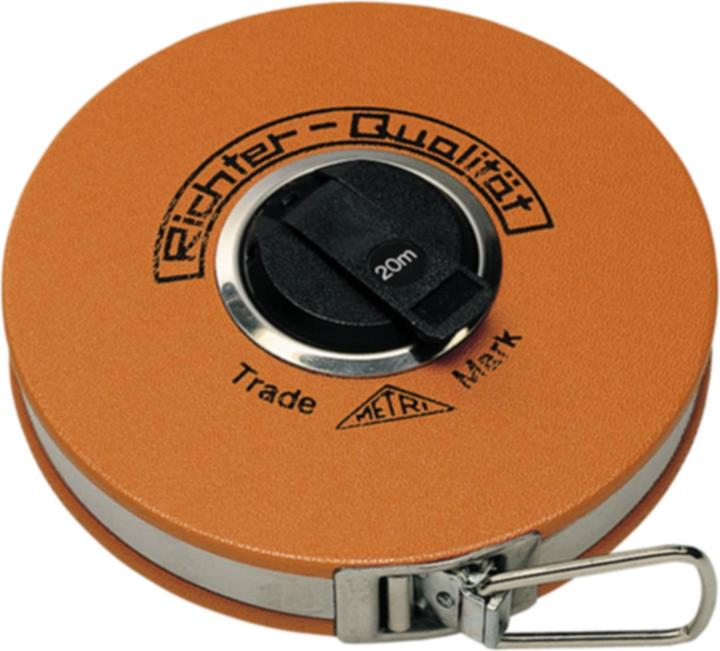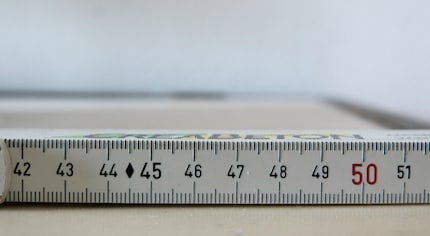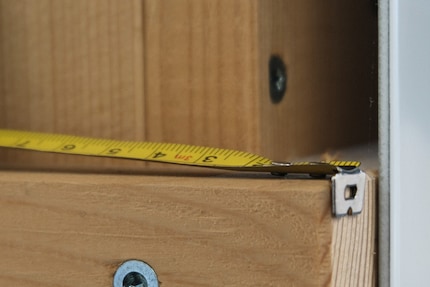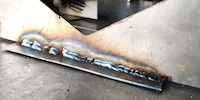

Why do tape measures have little black diamonds on them?
Tape measures let you calculate distances. And you can retract them again quickly once the job is done. All sounds straightforward enough so far. But some tape measures have black diamonds on them – what are they for?
To this day, roll-up tape measures still remind me of throwing contests in PE lessons. I wasn’t bad at it (like I was with apparatus work), but to get good I had to practice at weekends on the playing field with my dad. He always said it was important I didn’t throw the ball «like a bottler (editor’s note: like a loser)». Instead, he wanted me to throw it in a nice curve with my left arm outstretched. We always used to measure the distance with an orange Richter measuring tape.

But those days are long gone. Now I only use measuring tapes every once in a while to calculate distances that are more than two metres – in other words, when a double metre doesn’t cut it. I only noticed recently when I was using my measuring tape that it had diamond-shaped markings on it at regular intervals.
But why?
An answer, but no solution
I got in touch with Stanley Tools and someone in their customer service team answered my question. «The black diamond-shaped markings are also known as diamonds by the very nature of their shape. They’re set about 20 cm apart on some tape measures.» It’s already starting to get complicated. On my measuring tape, the distances are drawn on the inch scale, 19.2 inches apart, or 48.76 cm. But if we take my double metre, for instance, the diamond markings on there appear every 22 cm.

Maybe this will give us the answer: «These distances are known as trusses, like crossbeams or support beams on the wall of a room. The diamonds mark the distance between two trusses so that tradespeople can see where beams are and where they can drill without having to do any calculations.»
According to the manufacturer, the diamonds let you know where it’s best not to drill if you want to avoid damaging the statics of a house. I get the same answer from OBI E-Commerce GmbH and a Google search that leads me to an article from the magazine Focus.
You’d be forgiven for thinking that’s the mystery solved – when it comes to the double metre, at least. To put this theory to the test, I show Stanley Tools’s answer to a friend of mine who’s an architect. And this was his disenchanted reaction:
«I've never heard the word support beams. Do you mean posts?» he says when I show him the answer. «And 20 cm seems far too close to me for your average wooden substructure.» So I decide to dip deeper with tradespeople and the Swiss association of timber construction – Holzbau Schweiz(site in German).
Nobody seems to know for sure. None of the tradespeople I asked use these black diamonds in their everyday work. So, either these markings really have no use at all or there are a lot of people out there who are missing out on this great aid.
Tradespeople remember distances
Then I decide to hear it straight from the horse’s mouth and ask Marco Bonardi Gipser AG which distances they work with in drywall construction. «In terms of the substructure in the wall, the posts are 62.5 cm apart; in the ceiling, they’re 50 cm apart and in the case of the special fire protection structures, we work with a distance of 31 cm. We don’t need aids for determining distance. Once you’ve been in this line of work for a while, you just know that the first post is at 62.5 cm, the second at 125 cm and the third at 187.5 cm.»
That would still mean the truss answer didn’t fly. The double metres with their 22 cm don’t make sense in Swiss drywall installation and neither do measuring tapes with their 19.2 inches. So, what do the diamonds mean then? The jury’s still out.
Let’s try another manufacturer.
«I don’t see any diamond markings on our measuring tapes and rulers!»
That’s the short answer I got from the Bavarian Measurement Industry, Bayrischen Massindustrie (BMI). So that’s a dead end as well. That pushed me to the limit and I ended up starting a thread in a DIY forum:

I don’t even get a satisfactory answer there. Some users cite the Google result that mentions trusses, while others can’t even find the diamonds on their measuring tapes. Then there are those people who just want me to share the answer as soon as I find it out.
Born in the USA
Let’s go back to the drawing board. I trawl through the Internet again, looking at the person who wrote the truss answer and then I take a closer look at the companies that make tape measures with diamonds. In most cases, they can be traced back to the US, including my Birzman model. Slowly, it dawns on me. It all ties in with American measurements and construction methods. The diamonds refer to their trusses.
In the US, the standard size of a plasterboard for drywall construction is 8 feet (2.43 meters) long. And in order to attach the plate, you need a post structure. If you set a 19.2-inch distance (48.76 cm) between the individual posts, you get exactly six, which is why the distance has become standard. 16-inch distances are also used, so you end up with exactly seven posts per plasterboard.
The odyssey surrounding my measuring tape is over, the mystery has been solved and the results are in. It has absolutely zero benefit for DIY fans and tradespeople in this part of the world. But what about the double metre? Does it have some use to it we don’t know about? Don’t quote me on this but I found something in a trade forum(in German). I stumbled upon something that said these are elements of photoelectronic dimension inspection. It’s less about the exact distances than about the fact the diamonds are placed differently on each item so that you can check if the items are ordered properly.
But there is something that’s helpful
So you don’t click out of this article feeling completely discouraged and unsatisfied, I promise there is something tangible and helpful at the end. Notably, a measuring tape also has features you can actually use. For example, the metal bracket at the front has a hole that helps with measuring. If you don’t have anyone holding one side of the tool, you can put a nail through the hole instead and then carry on measuring the distance. What’s more, the bracket is often corrugated, which is designed to replace a pen. If you don’t have one to hand, you can slide the small plate back and forth a few times in order to leave a mark like this.

Incidentally, the bracket doesn’t wobble by accident, rather by design. This allows you to take precise external and internal measurements. If you want to work out the external size, the zero point is within the bracket (so it’s not counted). Conversely, when it comes to the internal dimensions, the bracket counts. That means you have to be able to move the band by a few millimetres.
Knowing these kinds of tricks is essential for precise work. But you can easily do without them when you’re throwing a ball in PE. And you can ignore the black diamonds – unless, of course, you’re emigrating to the US to live out your dream of being a homeowner there.
My life in a nutshell? On a quest to broaden my horizon. I love discovering and learning new skills and I see a chance to experience something new in everything – be it travelling, reading, cooking, movies or DIY.
Interesting facts about products, behind-the-scenes looks at manufacturers and deep-dives on interesting people.
Show all


